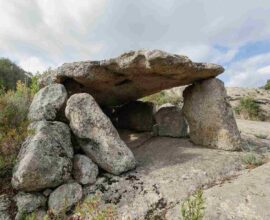Nuragic village of Barumini: history and curiosities
Barumini: Su Nuraxi Archaeological site
What immediately comes to mind when talking about Sardinia is the clear blue sea and white sand beaches, but the island has a lot to offer including fascinating areas full of history and timeless stories just like Nora and the archaeological park of Pula and the nuragic village Su Nuraxi in the land of Barumini.
Barumini is a municipality in the subregion of Marmilla in the south of Sardinia. It’s one of the largest settlements of the island and was rediscovered in the 50s during digs conducted by Giovanni Liliu a local and important expert on ancient nuragic civilization.
Su Nuraxi Archaeological complex was classified world heritage of humanity in 1997 by the UNESCO which now still protects the site alongside other precious historic testimonies, all of which is taken care of by the Fondazione Burumini Sistema Cultura, a foundation that promotes many initiatives per year so to popularise the history of this unique place.
Would you like to know more about the nuragic village of Barumini? Let’s discover together the history behind the ancient archaeological site of Su Nuraxi.
Barumini: Su Nuraxi, history of a symbolic nuragic civilization
The Su Nuraxi village of Barumini represents many historical eras starting from the XVI century BC to the VII AC, a timeline of over 2000 years.
The four lateral towers are built almost completely out of basalt, a hard volcanic stone from the high planes of Giara, and the bastion has four corner towers and one central one.
The nuraghe has become a symbol of the Sardinian territory, the landscape is dotted with cone-shaped stone constructions and stands in more or less 7000 areas spread across the island.
Between XVII and XIII BC, the nuragic village Burumini was built around the main tower, or donjon. The tower is defined a thòlos because of its troncoconic shape which holds round rooms with projecting walls and a “false vault covering”, or “false cupola”. The tower is built with a drystone wall of large blocks at the base positioned on top of each other which become smaller toward the top of the tower.
During the Recent Bronze age in 1300-1000 BC, four towers of 14 meters in height were built around the central one according to the cardinal points. A wall joins them together like a belt and there used to be a higher balcony which unfortunately did not survive over time. One can access the courtyard by going through the four lateral bastions, here there is a well which was used to connect the 2 circular rooms inside the various thòlos vault towers.
The first inhabited villages and protecting three outer wall towers which were renovated and amplified during the Final Bronze Age were also built during that period but there aren’t many remains. During XI-IX BC the four lateral bastions were also renovated and reinforced by building a 3metre thick wall around it.
Dating back to the Final Bronze Age are also the circular conic houses with wooden roofs, the most important one is “capanna 80” or “hut of the assembly” or “meeting hut” distinguished by a seat along the perimeter of the building and the 5 niches in the walls, here were found many utensils and vote symbols making us believe this place was used to host the communities’ assemblies.
Su Nuraxi was almost destroyed during the Iron Age, on its ruins were built houses of a new civilization capable of standing up to others. The huts were called “with the central court” or “in sectors” and had circular walls and a quadrangular plan, it’s thought they had a convex wooden roof over a round, paved courtyard.
The “round yard” is almost definitely the most important and meaningful environment. It was a small room with a false cupola, a centred seat and basin to collect water used during the purifying or lustral rituals.
Although the Punics occupied the territory during the V century BC, the nuragic civilization was not transformed so much, nor the structures of the villages nor the lifestyle of their inhabitants. Later, during II BC, the Romans used some of villages sites as burial grounds. It was inhabited until the III century AC and frequented also during the early medieval period (VII AC).
During the 90s, the restorations of Casa Zapata shed light on Su Nuraxi and Cresia, another nuraghe complex. Casa Zapata is an ancient noble residence built in mid-1500 over the nuragic buildings, it belonged to the Sardinian-Aragonese barons. The structure is now home to the Polo Museale Casa Zapata and is divided into three sections: Archaeological, historian and archivist and ethnographer.
Would you like to visit the nuragic village Su Nuraxi of Burumini and have a dreamlike vacation in a true paradise? Discover Forte Village resort in Sardinia.






